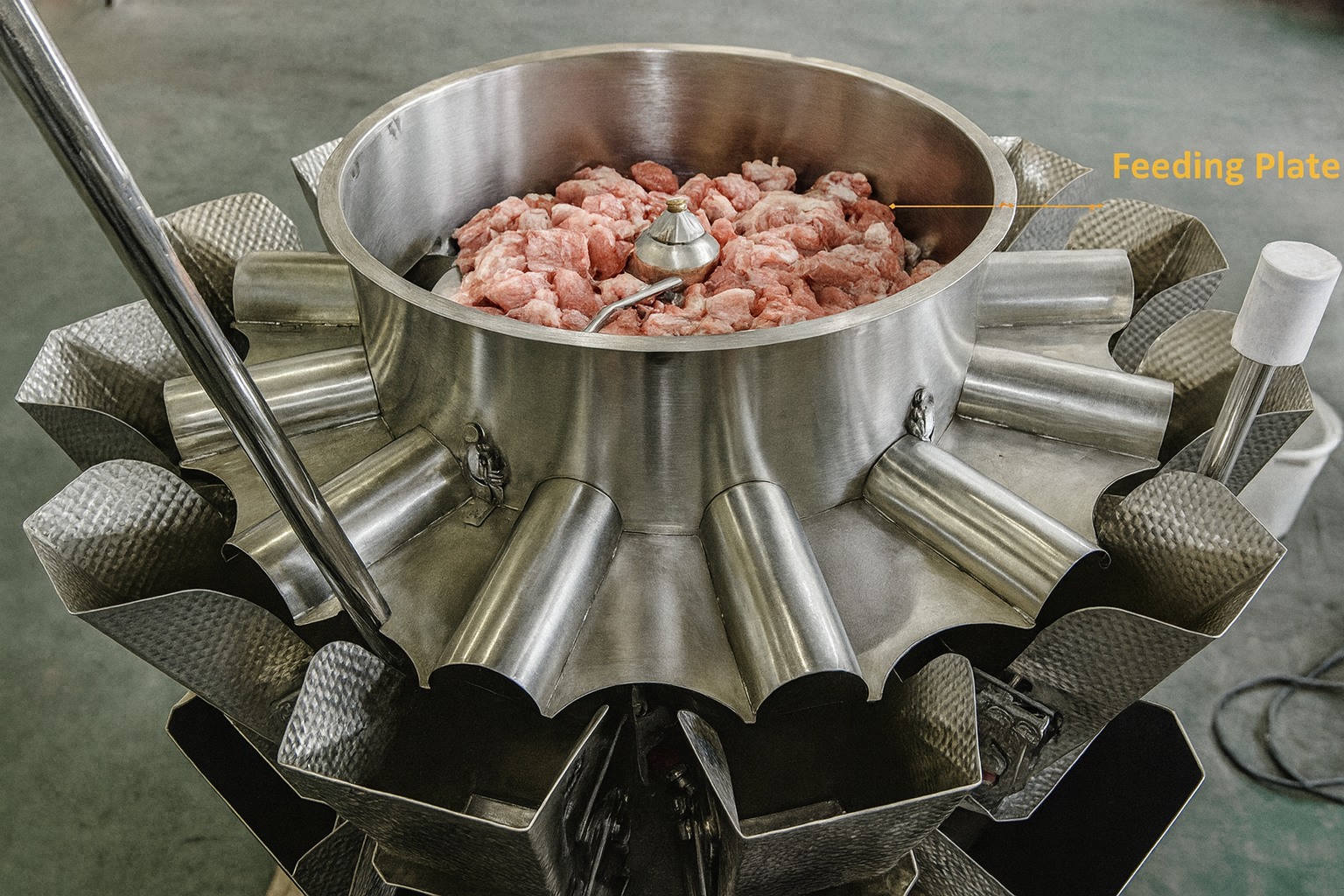Introduction: When Vibratory Feeders Fall Short
In the world of automated packaging, accuracy and efficiency are paramount. For many products, the standard multihead weigher with a vibratory feeder is a reliable workhorse. However, when faced with the challenge of weighing sticky, wet, oily, or otherwise difficult-to-handle products, these traditional systems can quickly become a major bottleneck. Product clumping, inaccurate weights, and constant downtime for cleaning are common frustrations that can severely impact a production line’s output and profitability.
This is where the screw feeder multihead weigher emerges as a specialized and indispensable solution. This guide provides a comprehensive framework for selecting the right screw feeder multihead weigher for your specific needs. By understanding your product’s characteristics and production requirements, you can choose a machine that not only solves your weighing challenges but also delivers a strong return on investment.

Why Standard Vibratory Feeders Fail with Difficult Products
Traditional multihead weighers rely on vibration to gently move product from a central distribution cone to the individual weigh hoppers. While this works well for dry, free-flowing products, it becomes ineffective for sticky or oily items.
– Product Adhesion and Blockages: Sticky products like marinated meats or gummy candies adhere to the pans, causing clogs and downtime.
– Inaccurate Weighing: Residue buildup on load cells leads to poor accuracy and inconsistent weights.
– Poor Flow Control: Non-free-flowing products do not move reliably with vibration, causing hopper underfill or overflow.
– Hygiene Issues: Sticky residues are difficult to clean, requiring more manual labor and downtime, and increasing food safety risks.
The Screw Feeder Advantage: Controlled, Consistent, Clean
Screw feeder weighers utilize rotating auger screws to gently advance the product forward. This controlled movement reduces buildup, improves accuracy, and enhances flow consistency.
– Eliminates Blockages: Active feeding keeps product moving, even if sticky or oily.
– High Accuracy: Load cells remain clean and accurate.
– Versatility: Handles marinated meats, salads, cheeses, and cooked pasta with ease.
– Sanitary Design: High IP ratings (IP66/IP67K) support frequent high-pressure washdowns.
Step-by-Step Selection Guide: Key Criteria to Consider
1. Analyze Product Characteristics
Understand how your product behaves:
– **Stickiness**: Requires non-stick coatings or scraper hoppers.
– **Moisture/Oil**: Needs stainless steel design and water-resistant components.
– **Fragility**: Use gentle screw pitch and lower RPM.
– **Clumping**: Optimize screw geometry for poor-flow products.
2. Define Production Requirements
– **Speed**: Number of heads impacts bags/min rate.
– **Accuracy**: Tight tolerances require precise load cells.
– **Mixing Capabilities**: Multi-component products need mix weighers.
– **Changeover**: Tool-less designs speed up frequent product changes.
3. Assess Hygiene & Environmental Conditions
– **Washdown Rating**: Go for IP69K in meat or fresh produce lines.
– **Material Construction**: Use 316 stainless steel for acidic or salty products.
– **Ambient Conditions**: Ensure compatibility with humidity or heat.
4. Evaluate Integration & Footprint
– **Packaging Compatibility**: Ensure discharge matches your VFFS or tray filler.
– **Space Constraints**: Choose a weigher that fits your height and width limits.
– **Connectivity**: SCADA or data logging support helps monitor performance.
Matching Configuration to Product Type: At-a-Glance Matrix
| Product Type | Key Challenges | Recommended Setup |
|————– |—————- |——————-|
| Marinated Meats, Seafood | Sticky, wet, oily | Screw feeder, scraper hoppers, IP69K |
| Leafy Greens, Fresh Salads | Wet, tangle-prone | Gentle screw, large hopper, anti-tangle settings |
| Shredded Cheese | Clumping, oily | Dimpled/Teflon hoppers, rotary cone |
| Cooked Pasta | Sticky, clumpy | Non-stick screw, soft feed motion |
| Gummy Candy | Very sticky | Teflon coating, scraper hoppers |
| Pickled Veg | Acidic, poor flow | 316 stainless steel, high IP rating |
Key Technical Specs: What You Should Understand
– **IP Rating**: IP67 = washdown safe; IP69K = high-pressure, food-grade cleanable.
– **Hopper Design**: Choose scraper or non-stick surfaces for difficult products.
– **Head Count**: More heads = faster output and better weight combinations.
– **Screw Type**: Match pitch, diameter, single type or double type ,and material to your product flow and fragility.
Conclusion: Invest in the Right Technology for Long-Term Gains
Choosing a screw feeder multihead weigher is more than a purchase—it’s a production upgrade. While vibratory systems suit dry, free-flowing materials, they fall short when handling sticky, oily, or fragile products.
By aligning machine selection with your product’s unique requirements, you can reduce waste, increase productivity, and enhance hygiene standards. The right machine won’t just perform—it will transform your line.
👉 Ready to upgrade your weighing efficiency?
**[Request a Quote or Product Trial](#)** today.

